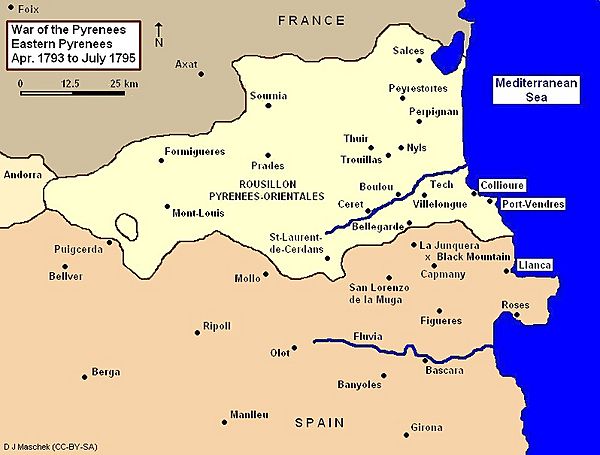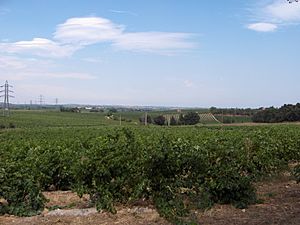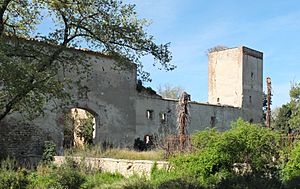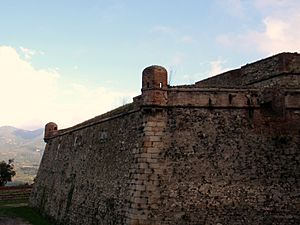Battle of Mas Deu facts for kids
Quick facts for kids Battle of Mas Deu |
|||||||
|---|---|---|---|---|---|---|---|
| Part of the War of the Pyrenees | |||||||
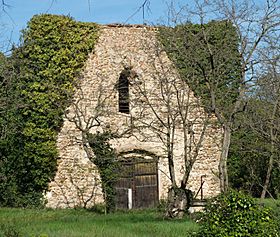 Chapel at the Commandery of Mas Deu |
|||||||
|
|||||||
| Belligerents | |||||||
| Commanders and leaders | |||||||
| Strength | |||||||
| 5,300 | 7,000–15,000 | ||||||
| Casualties and losses | |||||||
| 430 | over 34 | ||||||
The Battle of Mas Deu was a fight between the French army and the Spanish army on May 19, 1793. It was part of the War of the Pyrenees, which was a bigger conflict during the War of the First Coalition.
The battle took place near Mas Deu, a historic site east of Trouillas in Pyrénées-Orientales, France. The Spanish army, led by Antonio Ricardos, defeated the French forces, commanded by Louis-Charles de Flers. The French soldiers had to leave their camp and retreat to Perpignan. This Spanish victory allowed them to start a siege of Fort de Bellegarde, an important fortress that controlled a main road through the Pyrenees mountains.
Contents
Background to the Battle
Spanish Invasion Begins
On April 17, 1793, the Spanish army, led by General Antonio Ricardos, invaded France. He marched into Saint-Laurent-de-Cerdans with about 4,500 soldiers. They quickly pushed out 400 French soldiers.
Next, the Spanish moved towards Céret on the Tech River. On April 20, they met about 1,800 French soldiers. The fight was very bad for the French, who quickly ran away. Many French soldiers were killed or wounded, and some even drowned trying to cross the river. The Spanish reported very few injuries. General Ricardos left some troops at Le Perthus to watch the Fort de Bellegarde and protect his supply routes.
French Army Prepares
On May 14, 1793, Louis-Charles de Flers took command of the French army in the Eastern Pyrenees. Around the same time, more French soldiers arrived from the Army of Italy.
The French army set up their camp on a hill about 80 meters (260 feet) high near Mas Deu. This spot was good because it overlooked a plain and was protected by two deep stream beds.
History of Mas Deu
Mas Deu was originally a place built by the Knights Templar in the 12th century. It was like a headquarters for their large farms and properties in the Roussillon area. The Templars were a powerful and secret group, which made some people, like Philip IV of France, want their wealth.
In 1307, King Philip IV ordered all Templars in France to be arrested. Many were tortured or killed, and their wealth went to the French king. Later, the Pope also ended the Templar Order, and their properties were given to the Knights Hospitaller. Over time, the name of the place changed to Mas Deu.
Much later, during World War II, the old building was used by German soldiers to store ammunition. It exploded in 1944, destroying most of the old structure. Today, some parts still stand and are used as a winery.
The Battle of Mas Deu
Spanish Advance
On May 16, General Ricardos moved his army from Céret. He had about 12,000 foot soldiers, 3,000 horsemen, and many cannons. His army was divided into three main groups:
- The right side, with about 4,860 men, was led by Pedro Téllez-Girón, 9th Duke of Osuna.
- The center, with about 2,460 men, was led by Luis Firmín de Carvajal, Conde de la Unión. General Ricardos was with this group.
- The left side, with about 4,680 men, was led by Juan de Courten.
French Battle Plan
The French commander, De Flers, had a plan. He had only about 5,000 foot soldiers, 300 horsemen, and fewer cannons than the Spanish. His plan was to:
- Use French cannons to fire at the Spanish, keeping them in place.
- Have his left side make a fake attack on the Spanish right.
- Then, his stronger right side would launch the main attack.
The French left side had about 1,180 men, led by Claude Souchon de Chamron. The right side had about 2,680 men, led by Luc Siméon Auguste Dagobert. De Flers himself was with the center, which had about 740 soldiers.
Fighting Begins
On May 17, at 5:00 AM, two Spanish cannon groups started firing. They shot at the French camp for four hours. The French soldiers hid in the ravines (deep ditches) near their camp. Even with this long attack, the French held their ground that day.
On May 18, the Spanish tried to break through the French center. French counterattacks failed, and their cannons had to cover their retreat. By evening, the French line was still holding, but it was stretched thin because the Spanish had more soldiers. During the night, a rumor spread among the French that the Spanish were killing their outposts (small groups of soldiers guarding the camp). At 3:00 AM, shooting started, and many French soldiers panicked and ran back to Perpignan.
The Final Attack
On May 19, a French commander, Sauret, was wounded, and his soldiers started to retreat. General Ricardos saw this and ordered Osuna to attack the French camp with the help of 14 cannons. The French tried to fight back, but the Spanish soldiers were well-organized and pushed them back.
The French began to leave their camp and abandon their cannons. French horsemen tried to cover the retreat, but their commander, Mirabel, was wounded. De Flers tried to rally some soldiers, but they were also forced back by the Spanish cavalry.
Results of the Battle
The day after the battle, Perpignan was full of tired soldiers and scared people who had fled. Local leaders used churches and other buildings to house the refugees. De Flers tried to encourage his soldiers, but some volunteer groups refused to fight and had to be disbanded.
Historians say the Spanish army had about 7,000 men. The French lost about 150 killed and 280 wounded. They also lost three cannons and six ammunition wagons. The Spanish reported only 34 killed, but did not say how many were wounded.
Instead of chasing the French, General Ricardos decided to turn back and attack Fort de Bellegarde. This fortress was very important because it controlled the main road through the Pyrenees mountains at the Col du Perthus.
Siege of Bellegarde
The Siege of Bellegarde started on May 23 and lasted until June 24. The French commander, Colonel Boisbrulé, surrendered the fortress with 1,450 surviving soldiers. The fortress had many cannons and mortars. The Spanish kept about 6,000 soldiers and 34 guns around the fortress during the siege.
While the main siege was happening, the Spanish also had to capture two smaller forts nearby, Fort les Bains and Fort de la Garde. These surrendered on June 3 and June 5. The French tried to send supplies to Bellegarde on May 29, but their attempt failed.
After the battle, on May 24, De Flers began building a new camp called Camp de l'Union near Perpignan. As a result of the battle, Dagobert was promoted to divisional general, and Sauret was promoted to colonel. On the Spanish side, Osuna was moved to another army in October because he was difficult to work with.
See also
 In Spanish: Batalla de Mas Deu para niños
In Spanish: Batalla de Mas Deu para niños


